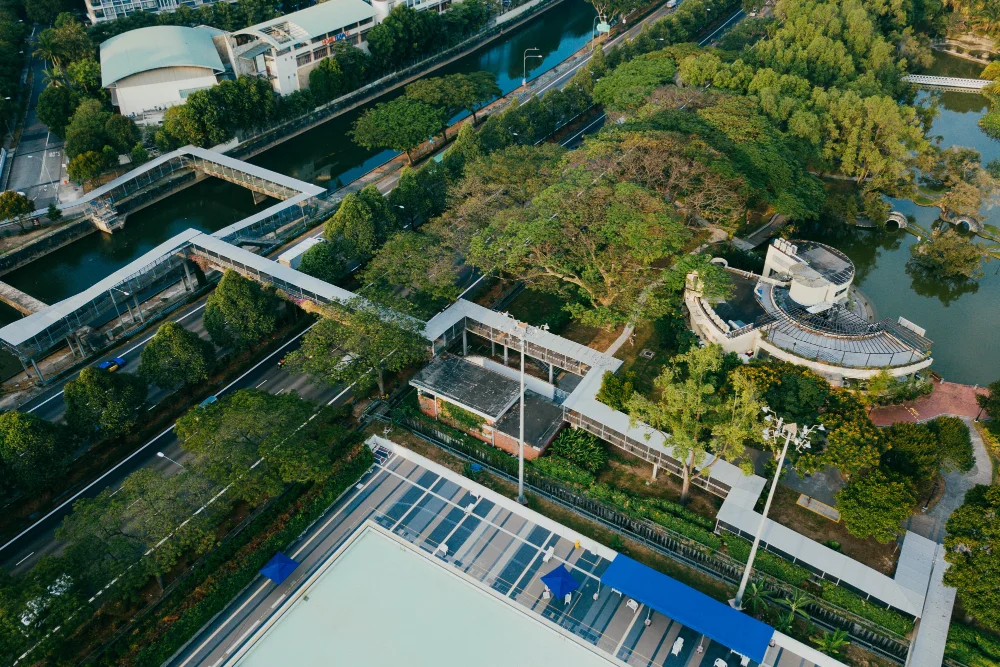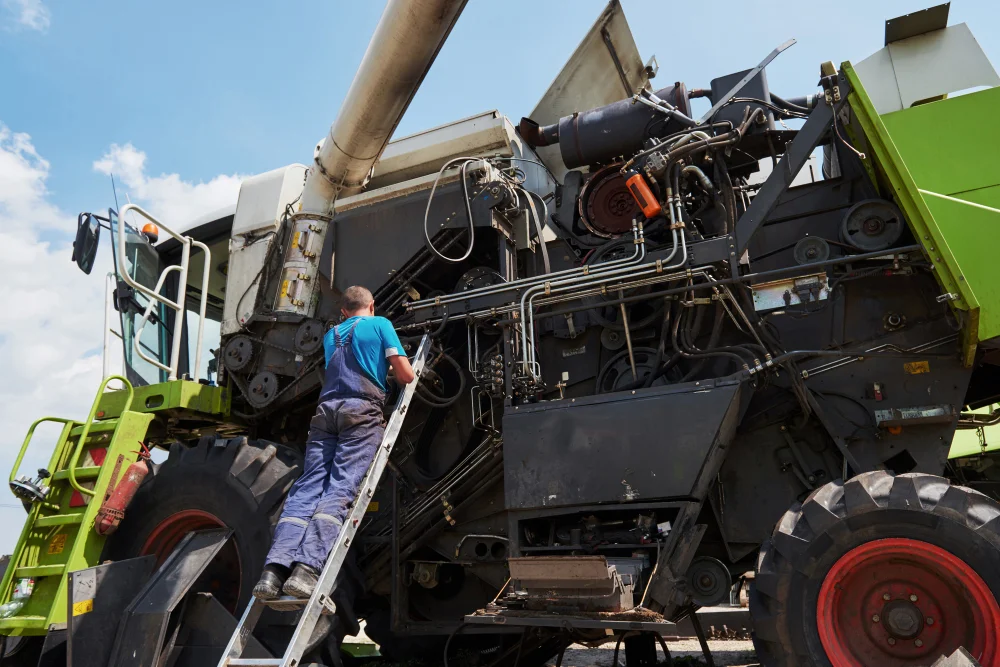As electrical networks, pipelines and telecommunications infrastructure continue to expand, maintaining utility corridors has become a critical operational priority. Fire hazards, storm damage and uncontrolled vegetation growth demand effective, field-proven solutions.
Utility corridor clearing with heavy-duty mulchers now stands as the industry standard, combining high-efficiency vegetation management with precision forestry mulching.
Using purpose-built equipment, crews can ensure reliable access, control costs, minimize environmental impact and preserve surrounding landscapes, even in remote or difficult terrain.

Maintaining utility corridors is essential to ensure the continuous flow of energy, data and fluids across regions.
Whether they carry high-voltage power lines, fiber-optic cables, oil pipelines or water infrastructure, these corridors form the backbone of modern society. Their upkeep directly impacts critical systems, from emergency response networks to economic activity and everyday public services.
Overgrown vegetation, soil instability or neglected maintenance can compromise infrastructure integrity and lead to severe consequences, such as widespread service outages, environmental damage or public safety hazards.
Therefore, utility corridor clearing is not a discretionary task but a strategic responsibility that demands methodical planning, specialized equipment and strict adherence to regulatory frameworks.
To keep networks operational and resilient, utility managers often draw on lessons from pipeline right of way maintenance, where consistent vegetation management prevents costly disruptions and environmental liabilities.
Ensuring the operational reliability of utility infrastructure requires consistent and proactive vegetation control.
Trees encroaching on power lines or root systems disturbing underground pipes can lead to unexpected outages, equipment malfunctions or even safety incidents.
Regular clearing of the right-of-way (ROW) zones allows utility providers to maintain unobstructed access for inspections, repairs and upgrades, significantly reducing emergency interventions.
Preventive maintenance through forestry mulching and other vegetation management techniques also extends the lifespan of infrastructure assets by mitigating physical stress caused by environmental encroachment.
The long-term benefit is a more stable, resilient and cost-efficient network that serves both urban and remote communities without interruption.
This approach aligns with practices developed in fire prevention and firebreaks work, where consistent corridor maintenance mitigates both operational and environmental risks.
In regions prone to wildfires or extreme heat, unmanaged vegetation along utility corridors becomes a major fire hazard.
Dry brush, tall grasses and overhanging branches can serve as ignition points, especially near electrical equipment or during periods of high voltage load.
Strategic clearing not only reduces the available fuel for wildfires but also creates defensible spaces that help contain potential outbreaks. Beyond safety considerations, utility companies must comply with stringent regulations concerning land use, environmental impact and worker safety.
Standards such as Alberta’s Occupational Health and Safety Code or U.S. regulations like the National Electric Safety Code (NESC) require companies to document and implement systematic corridor management plans.
Failure to meet these requirements can result in legal liability, environmental fines and reputational damage.
By investing in compliant clearing strategies with certified equipment and trained personnel, companies minimize risk while maintaining public trust and operational continuity.
Many operators incorporate tips from post-fire restoration projects, ensuring corridor clearing not only prevents incidents but also supports ecological recovery where fires have already occurred
Heavy-duty mulchers have revolutionized vegetation control within utility corridors by delivering consistent performance across diverse landscapes, while reducing both environmental impact and operational complexity.
These machines combine power, precision, and versatility to meet the demanding standards of energy, telecommunication, and pipeline infrastructure projects.

Skid steers, tracked carriers, excavator mulchers and specialized Kubota units are designed to handle dense vegetation and variable terrain with remarkable efficiency. Unlike traditional mechanical clearing methods, these machines can be precisely maneuvered around infrastructure elements such as utility poles, pipelines, and fences, making them suitable for both linear corridors and irregular ROW boundaries.
Their engineering allows for:
This capability is essential for utility managers seeking to maintain clear corridors while avoiding costly damage to the surrounding environment or infrastructure.
The same precision approach is used in municipal land management where equipment must work around existing infrastructure while preserving surrounding landscapes.
Heavy-duty mulchers are equipped with advanced safety systems that significantly reduce the exposure of workers to high-risk tasks. Reinforced operator cabs, rollover protection structures (ROPS), and remote-control features allow for safe operation even in hazardous zones, such as near high-voltage lines or unstable terrain.
Moreover, their deployment contributes to better budget control and shorter project timelines:
For utility companies operating under tight regulatory and financial constraints, heavy-duty mulchers offer a scalable and cost-effective alternative to conventional clearing techniques, while simultaneously raising the bar for safety and environmental responsibility.
These cost and safety advantages mirror the gains achieved in solar and wind farm site preparation, where tight deadlines meet strict safety rules.

Utility corridor clearing with heavy-duty mulchers requires more than just powerful equipment. Effective outcomes result from thorough planning, selecting the right technology, and following strict operational protocols. Each phase of the project impacts safety, environmental compliance, and the longevity of the cleared corridor.
A successful clearing operation begins with a comprehensive assessment of the project site. This involves detailed analysis of the terrain, vegetation types and density, as well as regulatory and environmental constraints. Proper preparation ensures that the selected machinery and techniques match the site’s specific challenges, reducing risks and optimizing efficiency.
Key elements of site evaluation include:
This foundational work allows project managers to devise a tailored clearing plan that balances operational demands with environmental stewardship.
Drawing on knowledge from mining and extraction zones, project managers also consider soil stability, drainage, and access routes to optimize efficiency and minimize risk.
During clearing, operations follow a structured workflow designed to maximize safety and effectiveness. Work zones are clearly defined, and crews strictly adhere to personal protective equipment (PPE) standards to mitigate occupational hazards. Equipment undergoes routine inspections before and during use to prevent mechanical failures.
Typical operational stages include:
Constant communication among team members is vital, ensuring that any unexpected obstacles or safety concerns are addressed immediately. These practices help maintain a safe work environment while achieving thorough vegetation management.
The discipline applied here is similar to roadside and railway clearing, where public safety and operational continuity are equally critical.
After clearing is complete, a final site inspection verifies that objectives have been met and identifies any zones requiring special attention, such as protected species habitats or areas slated for replanting. Teams document these findings alongside operational data, including equipment usage and personnel logs.
This documentation serves several purposes:
Maintaining detailed records is essential for demonstrating adherence to safety and environmental standards, which can facilitate smoother project approvals and long-term utility corridor sustainability.
Heavy-duty mulching goes beyond simple vegetation removal, positioning itself as one of the most sustainable and cost-effective methods for managing utility corridors. This technique balances ecosystem preservation with operational efficiency, delivering lasting advantages for both the environment and project budgets.

The process of intensive mulching transforms vegetation into fine organic matter that acts as a natural mulch layer, enriching the topsoil and contributing to several key ecological functions:
Compared to traditional clearing methods such as bulldozing or herbicide application, forestry mulching helps sustain the ecological balance, protecting sensitive species and promoting healthier landscapes.
By converting cleared vegetation into mulch, the process stabilizes soil, retains moisture, and allows natural regeneration. This supports biodiversity by preserving root systems and reducing erosion, principles often applied in storm cleanup where disturbed soils need immediate protection.
The organic mulch left on site acts as a natural suppressor of rapid vegetation regrowth by blocking sunlight and enriching the soil with nutrients as it decomposes slowly. This biological process effectively delays the return of dense underbrush, which in turn reduces the frequency at which clearing operations need to be repeated. By extending the intervals between maintenance cycles, operators save significant amounts on labor and equipment deployment costs.
In addition, fewer clearing events mean less fuel consumption overall, since heavy machinery is used less intensively and transport trips to and from the site decrease accordingly. This reduction in operational demands also lessens wear and tear on expensive mulching equipment, prolonging its service life and lowering repair and replacement expenses. Moreover, with fewer vehicle movements and minimized soil disturbance, the overall carbon footprint of the maintenance process is substantially reduced, supporting environmental sustainability goals.
This effect produces considerable economic benefits:
Overall, intensive mulching offers a sustainable vegetation management strategy that decreases total operational costs while supporting environmental objectives, making it a preferred choice for utility corridor maintenance in the long term.
For more insight into long-term asset care, see our resources section for case studies and operational guides.

Safety is a fundamental aspect of utility corridor clearing, especially when operations take place near live electrical lines, public roadways or residential areas.
These environments present inherent risks such as electrical hazards, traffic interactions, and close proximity to people and property, which require meticulous attention and rigorous control measures.
Proactively managing these risks involves not only identifying potential dangers before work begins but also continuously monitoring conditions during operations to adapt to any changes or unexpected events.
This vigilance protects the health and well-being of workers by preventing accidents and injuries, safeguards the public from exposure to hazards, and limits environmental damage.
Moreover, maintaining a strong safety culture and effective risk management protocols ensures that clearing activities proceed without interruptions, minimizing downtime and avoiding costly service outages.
Prioritizing safety is essential for the success and sustainability of utility corridor maintenance projects, preserving both human life and critical infrastructure.
Strict adherence to safety protocols is essential to minimize accidents and injuries directly on-site, especially in sensitive environments like utility corridors. Every operation begins with the right personal protective equipment, selected according to the specific hazards present, whether live electrical lines, flying debris, or uneven terrain.
Key safety measures include:
Moreover, only trained and certified operators skilled in handling heavy-duty mulchers in high-risk environments work on these sites. This field-focused training ensures they can manage complex situations effectively and respond promptly to incidents.
Combining the right equipment, constant vigilance, and solid training is key to safeguarding crews and ensuring continuous operation on utility corridors.
Utility corridor projects must comply with a range of national and regional regulations, including Alberta Occupational Health and Safety (OHS) requirements, Dominion Electric safety codes and environmental management frameworks.
Compliance covers multiple aspects such as:
Selecting partners who thoroughly understand and apply these regulatory obligations is crucial to obtaining project approval, maintaining legal compliance and ensuring the long-term viability of corridor maintenance efforts.
Project cost depends on:
Despite these variables, heavy-duty mulching remains one of the most cost-effective solutions available.
Tracked carriers, skid steers, hydraulic mulchers and compact excavators are common choices. The final selection depends on slope gradient, soil type and environmental constraints.
Working with certified professionals who understand regional regulations and prioritize low-impact mulching is key. Maintaining thorough documentation, maps and post-project assessments supports long-term compliance.
Yes, heavy-duty mulchers allow for faster vegetation control without compromising safety or soil health. This is particularly valuable in emergency response situations or during seasonal weather windows.
All reputable contractors apply strict safety standards. From PPE and safety briefings to on-site signage and remote monitoring, every aspect of the job is designed to protect crews and nearby communities.
Utility corridor clearing with heavy-duty mulchers is now the gold standard for sustainable, safe and efficient vegetation management. When executed with professional equipment and certified crews, it minimizes environmental impact, reduces maintenance costs and protects infrastructure long term.
To manage utility maintenance, vegetation control and regulatory compliance with confidence, partner with a team that specializes in forestry mulching and advanced clearing techniques.
With the right approach, equipment, and partner, utility corridor clearing becomes a predictable, safe, and sustainable operation. If you want to learn more about our expertise and track record, visit our about us page or contact us for a project review.
To provide the best experiences, we use technologies such as cookies to store and/or access device information. Consenting to these technologies will allow us to process data such as browsing behavior or unique IDs on this site. Failure to consent or withdrawing consent may adversely affect certain features and functions.